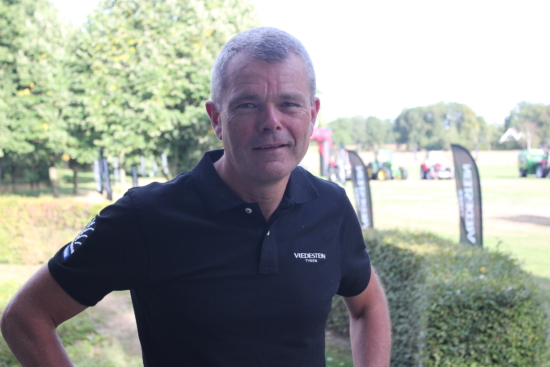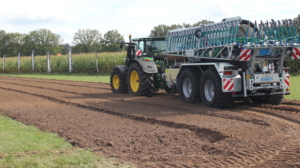Apollo targeting 50% increase in off-highway tyre share: Interview with European president Benoit Rivallant
 Set against the background of rural Netherlands farm, land just 400 metres from the border with Germany, Apollo Tyres Europe president Benoit Rivallant both celebrated the 25 history of the company’s Vredestein-branded Traxion agricultural tyre technology and set ambitious revenue targets (Photo: Chris Anthony/Tyre Industry Publications Ltd.)
Set against the background of rural Netherlands farm, land just 400 metres from the border with Germany, Apollo Tyres Europe president Benoit Rivallant both celebrated the 25 history of the company’s Vredestein-branded Traxion agricultural tyre technology and set ambitious revenue targets (Photo: Chris Anthony/Tyre Industry Publications Ltd.)
During Apollo Tyres’s recent celebration of 25 years of Traxion agricultural tyre technology, Europe president Benoit Rivallant set an ambitious target of growing the company’s off-highway tyre (OHT) revenue by 50 per cent. In Europe, 16 per cent of total revenue originates from the off-highway tyre sector. This compares with 63 per cent from passenger car tyres, 12 per cent from truck and bus tyres, 8 per cent from spare tyres, 1 per cent from bicycle tyres and 1 per cent from other products. In other words, the 16 per cent originating from off-highway tyre sales is a strategically important figure, 92 per cent of which comes from the agricultural sub-segment. Tyres & Accessories took time out with the company’s European head in order to find out more about how executives plan to achieve such ambitious targets in the context of a broadly challenging tyre market environment.
So, in light of the company’s ambitious goals for the future growth of Apollo Tyre group’s European off-highway tyre sales, how will the segment look in the future? “Agri, which is 90/92 per cent of [OHT] sales today, will remain the lion’s share. What we consider is that…there is a big shift between what is produced locally and what is produced by European brands – sometimes produced overseas and imported. Regarding the evolution in the markets…the market has been going down when we take the European pool [as a reference point], but the total market is not going down…The agricultural sector has been resilient during Covid. Every year…passenger car, truck, aircraft, mining, everything was going down. The only thing that wasn’t – we still have the same number of mouths to feed worldwide – was agri. And that proves that the agricultural tyre market will keep growing.”
But while growth in the global population is an undeniable fact, Apollo Tyres is not the only tyre manufacturer to notice the resilience and therefore importance of the off-highway tyre market. How is the company planning to achieve its ambitions in light of increased competition?
“What’s happened is that there has been a redistribution of the players and the demand from the farmer and vehicle makers. With our manufacturing strategy we are well-equipped to address that,” Rivallant explained, specifically pointing out that the company has the right people and know-how both here in Europe and India, which after all is “the biggest agricultural tyre market in the world.”
Which, of course, leads us to the discussion of how the Apollo and Vredestein brands work together in the wider off-highway tyre sector. “So, from very small equipment in India to very large equipment in Europe, we know our business and then we have R&D in both. So that means…we have the people, the R&D, and the manufacturing – we are somewhat future-ready.”
Picking up on what appeared to be a veiled reference to the off-highway mergers and acquisitions activity that has taken place in the off-highway sector in recent years, how does Apollo/Vredestein’s strategy relate to the specifics of the changes in the competitive environment? For example, the fact that Yokohama now owns both the Alliance Tyre Group and its brands and Trelleborg/Mitas as part of its off-highway tyre business. Does Apollo have plans to grow by acquisition as well?
Real-life flotation performance, helping farmers minimise soil compaction is at the heart of the Traxion’s range (Photo: Chris Anthony/Tyre Industry Publications Ltd.)
“The group Yokohama is growing by acquisition, but that doesn’t mean that every brand is selling more. So, when we say that we want to sell [more], we want to grow faster than our competitors. Yes, Yokohama has been growing through acquisition, but this is only year one…This acquisition is generating its own set of difficulties because it is multi-brand. It is very difficult to manage multi-brand. For us, we have a different approach, we are – I would say – mono-brand. When I say mono-brand, agri is Vredestein, so 100 per cent of our effort goes towards Vredestein. And when we speak about construction – it is Apollo. For these users, they can be confident that we give the best of our knowledge, of our technology, of our quality to the brand Apollo.”
In short, there is no way that European customers can buy Apollo branded tyres for the agricultural sector because they are not designed for the same vehicles and fitments as the agricultural tyre range. The two are intentional given their own – separate – furrows to plough, so to speak.
Managing production in the face of macro-market pressures
With all the pressures that the market has faced in recent years, we have to ask how Apollo Tyres is navigating the various parts of the storm and how the company’s position has fared throughout it all.
“We monitor our market share. The fact that we are a global player and that we invest on a global scale means that – since the acquisition of Vredestein by Apollo – the company has the scale and financial backing to be increasingly competitive within Europe. Of course, we want profitable growth…the ambitions of the Apollo group have been previously announced – we want to get into the top 10 tyre manufacturers in the world. Agri tyres are part of this ambition.”
Specifically, how has Apollo managed to maintain manufacturing and the necessary supply of raw materials for manufacturing (such as carbon black) in light of the many combined pressures of recent years (namely the pandemic, shipping costs and the war in Ukraine)?
“It still can generate some sleepless nights, let’s put it that way. With Covid, the fair question was: how can I still run my factory? That was one period. Then after what we…had all the disturbances that can happen in the supply chain [the problem with the freighter blocking the Suez canal was one such given example], difficulty getting the containers, difficulty getting raw materials. Already then, we were looking into how to address that situation.
“For example, [out of the hundreds of elements required to make a tyre] where do we have only one supplier? And eventually on only one continent. Because then we are at-risk….More recently, we have two priorities: to make sure, with what is happening in Russia and Ukraine – but also Belarussia…- to be totally hermetic to that. We have found solutions. And the fact that we are smaller than some of our competitors helps us. We also take inventories to make sure we are protected. But [together] this is the way that we have to date avoided a big impact on production.”
Unfortunately, prices must go up
So, that’s how the company has kept going in practical terms, but how has the company kept moving forward in the face of economic pressures? “The next crisis that is coming is inflation in the price of raw materials and, in fact, in energy. And what about the supply of gas and electricity this winter? It is clear that we are in an inflation circle. We have no other option than, unfortunately, prices must go up.”
Furthermore, regarding input price increases, “there is also a difference between the prices that you can read today on indices and the real production cost. In fact, today we produce today at the cost of three months ago because there is a lag between the two.”
Given the fact that our interview took place against the background of rural Netherlands farmland, just 400 metres from the border with Germany, the obvious question is how does this fit in its market context? “There is a general understanding that farmers’ income is not at the level it should be considering the effort put in,” and yet it is also clear that some industries cannot avoid putting up costs. The answer, according to Rivallant, is to support the farmer as far as possible so they can get the best price for their products.
“there is also a difference between the prices that you can read today on indices and the real production cost. In fact, today we produce today at the cost of three months ago because there is a lag between the two.”
And that means further product development as well digitisation strategies. “Everything starts with the product and the quality of the people. When we target a geography, we first establish the right team. As part of the product, we have to consider digital. There are two parts of this: the product and the relationship with the customer.” In other words, the challenges of product digitisation are: to connect the product with the drivers or the operators (one is in the vehicle and one is in the despatch centre); and then the other is to bridge the gap between data and real-time action – as car OEMs have with ESP, for example.
And with the right products, paired with the right technology and put in the right hands, a viable route to future success can be established – if, indeed, the macro pressures and the competitive environment can also be successfully


 (Photo: Adem AY; Unsplash)
(Photo: Adem AY; Unsplash) moveero
moveero

Comments